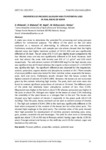| dc.description.abstract | A study was done to determine the potential for processing and using prosopis juliflora for commercial purpose. The effects of the plant on the soil were evaluated as a measure of determining its influence on the environment. Preliminary analysis of three soils samples per site where showed that the highly infested areas had higher moisture content of 10.5+1.35% and was significantly different at 5% level. The pH value of 8.7+1.03 was slightly lower compared to the low infested areas and was not significantly different at 5% level. However, both soils had almost the same bulk density and ECE of 1.1 g/cm3 and 0.03 dm/S respectively. The soil calcium content of 0.88+0.009 mg/l in the high density area was significant low at 5% level whereas the organic carbon content of 1.13+0.027% was significantly high. No significant difference was observed for the magnesium, sodium, potassium, organic matter and phosphorus content at 5% l. Plant samples of prosopis juliflora were also tested for their nutritive values, especially the leaves, pods, bark and roots. Preliminary results showed that the leaves contain the highest amount of calcium of 6.38+0.248%. However, the leaves are not consumed green by the animals indicating high toxicity. The pods, bark and roots were also found to contain significant proportions of calcium at 5% level. The different parts of the plant had relatively lower phosphorus content of less than 0.25%. Magnesium was higher in the bark at about 3.5% whereas potassium was higher in the pods at about 2%. Nitrogen was higher in the leaves at about 2.5% indicating the suitability of the plant leaves as a nitrogen fixer in the soil. The tissues also showed very high content of vitamin C especially in the green pods (46.3+5.18 m/100g). Thus the pods, leaves and bark can be used as natural sources of vitamin C. The high ash content of 8.9+1.19% in the bark was significantly different at 5% level when compared to the content of the leaves but not other plant parts. This showed high roughage in the plant parts. The nutritive value of the pods showed their high potential for development of nutritive products including juice, wine, gum, powder, essential oils and beverages. The yield for aloe roots as fermenting agent was about 7.1% on 9th day in Prosopis extract having sugar media, 6.3% for yeast, Prosopis extract and honey on the sixth day and 6.1% for extract, sugar and baobab on the sixth day. | en_US |

